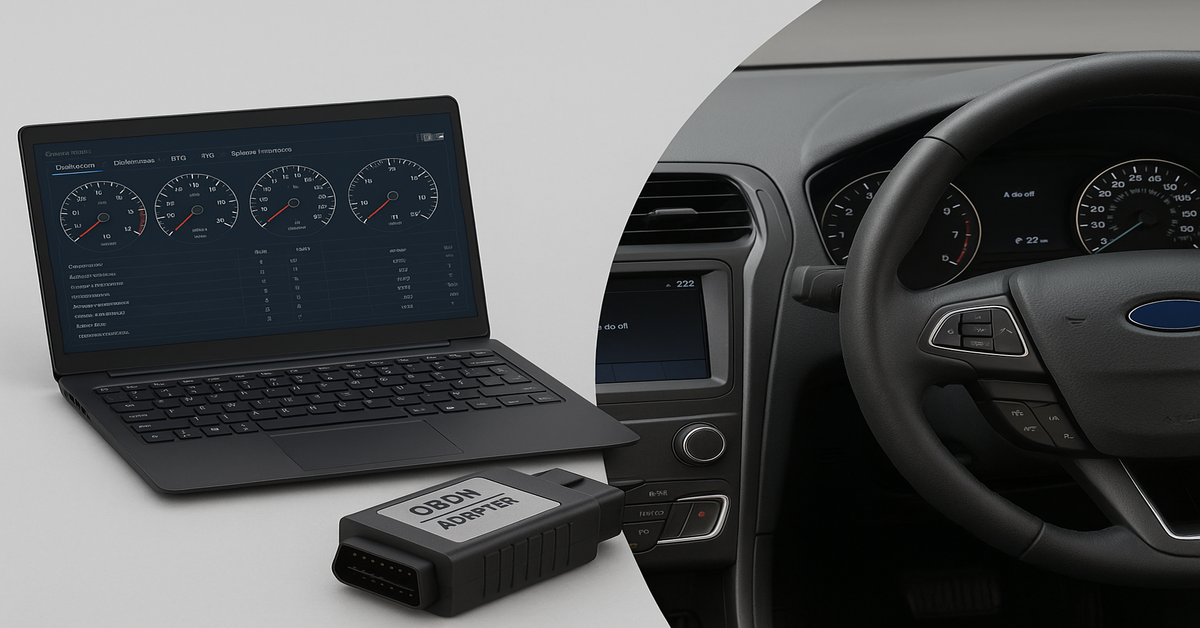
Modern vehicles are no longer just mechanical machines. They are integrated systems where electronic control modules (ECMs) play an equally important role as the engine, transmission, or suspension. For vehicles made by Ford, Lincoln, Mazda, and Mercury, a specialized software tool called FORScan has become one of the most powerful resources for diagnostics, customization, and maintenance. Unlike generic OBD-II scanners, FORScan is tailored specifically to Ford’s ecosystem, enabling users to access modules and functions that are otherwise restricted to dealership tools.
This article explores FORScan in detail, covering its purpose, how it works, installation process, compatibility, real-world uses, advantages, limitations, and best practices. By the end, you’ll have a thorough understanding of how FORScan can transform the way vehicle owners, DIY enthusiasts, and professionals approach automotive diagnostics.
What is FORScan?
FORScan is a diagnostic and configuration software designed specifically for Ford, Lincoln, Mazda, and Mercury vehicles. Unlike general OBD-II tools, which focus mainly on emissions and basic fault codes, FORScan communicates with the deeper layers of the car’s electronic network. It recognizes protocols and modules unique to Ford, giving users access to advanced parameters, live data, service functions, and configuration options.
Think of it as the bridge between your laptop (or mobile device) and your vehicle’s brain. With FORScan, you can read hidden codes, monitor real-time performance, perform system resets, enable or disable factory settings, and even program new features.
Why FORScan Stands Out
Most diagnostic tools available in the market are universal, meaning they are designed to work with multiple car manufacturers but often in a limited capacity. Ford vehicles, however, use specific communication protocols such as MS-CAN and HS-CAN. Standard scanners fail to read data from these networks effectively.
FORScan stands out because:
- Deep Module Access – It can read information from modules like ABS, PCM, BCM, IPC, TCM, and more.
- Extended Diagnostic Functions – Beyond reading and clearing codes, it can run tests such as injector coding, DPF regeneration, and steering angle calibration.
- Customization – Users can enable hidden features like digital speedometers, auto-lock, or DRL (Daytime Running Lights) adjustments.
- Cost Effectiveness – Compared to dealership tools, FORScan provides nearly the same functionality at a fraction of the cost.
How FORScan Works
At its core, FORScan operates as a software application installed on a PC, laptop, tablet, or smartphone. To connect with the vehicle, it requires an OBD-II adapter that supports Ford-specific protocols.
Here’s the typical workflow:
- Install FORScan on your device (Windows, iOS, or Android).
- Connect an OBD-II adapter (such as ELM327 USB, Bluetooth, or Wi-Fi).
- Plug the adapter into the OBD-II port of the vehicle.
- Launch FORScan and allow it to detect vehicle modules.
- Access diagnostic functions such as reading DTCs (Diagnostic Trouble Codes), running service functions, or modifying settings.
System Requirements
Before diving into FORScan, it’s essential to understand its basic requirements.
| Requirement | Details |
|---|---|
| Supported Devices | Windows PC/Laptop, Android, iOS |
| OBD-II Adapter | ELM327 (USB, Bluetooth, or Wi-Fi) with HS/MS-CAN switch |
| Vehicle Coverage | Ford, Lincoln, Mazda, Mercury (various models from late 90s onwards) |
| Internet Access | Required for software updates, license activation, and some service functions |
Installing FORScan
Step 1: Download the Software
The software is available from the official FORScan website. Versions are provided for Windows, Android, and iOS. The Windows version is the most feature-rich, while mobile versions are optimized for portability and convenience.
Step 2: Install the OBD-II Driver
For USB adapters, install the driver provided by the manufacturer to ensure smooth communication.
Step 3: Connect to the Vehicle
Locate the OBD-II port (commonly found under the dashboard near the driver’s side). Plug in the adapter.
Step 4: Launch FORScan
Open the application, and it will automatically identify your vehicle, including VIN, model year, and supported modules.
Step 5: Begin Diagnostics
Once connected, you can explore functions ranging from reading codes to running specific service resets.
Key Features of FORScan
1. Reading and Clearing DTCs
Unlike generic scanners that only access powertrain modules, FORScan can read codes from dozens of modules, including ABS, airbag, transmission, and body control.
2. Real-Time Live Data
FORScan allows users to view live sensor data in graphical, numerical, or table format. This helps diagnose issues like fuel trims, temperature fluctuations, or misfires.
3. Service Functions
Functions such as resetting adaptations, performing injector coding, bleeding ABS modules, or regenerating diesel particulate filters make it valuable for mechanics and advanced DIYers.
4. Module Programming and Configuration
Users can adjust vehicle settings that are typically locked. Examples include:
- Enabling digital speed readout
- Customizing lighting behavior
- Disabling seatbelt chimes
- Activating global window controls
5. Compatibility with Extended PIDs
FORS-can supports Parameter IDs (PIDs) unique to Ford vehicles, making monitoring more accurate.
Benefits of Using FORScan
- Comprehensive Coverage – Access to modules and parameters otherwise hidden from universal scanners.
- Affordability – A one-time software and adapter purchase saves thousands compared to dealership visits.
- User-Friendly Interface – Designed to be intuitive even for non-professionals.
- Regular Updates – Developers continually expand coverage for newer models.
- Customization Freedom – Personalize your vehicle without aftermarket hacks.
Common Uses of FORScan
- Diagnosing check engine light and other warning indicators
- Resetting oil change reminders
- Programming new keys and remotes
- Testing actuators like fans, injectors, or relays
- Performing battery monitoring system (BMS) resets after battery replacement
- Adjusting tire size calibration for speedometer accuracy
Limitations of FORScan
While powerful, FORS-can does have limitations:
- Vehicle Specificity – Only works with Ford, Lincoln, Mazda, and Mercury.
- Learning Curve – Some advanced functions require technical knowledge.
- Adapter Quality Matters – Poor-quality ELM327 clones can cause communication errors.
- Limited on Mobile – Full functionality is best experienced on Windows.
Choosing the Right OBD-II Adapter
| Adapter Type | Pros | Cons |
|---|---|---|
| USB | Stable, fast communication, affordable | Requires laptop, less portable |
| Bluetooth | Convenient, wireless, works with phones | Potential interference, slower response |
| Wi-Fi | Works with iOS devices, wireless | Slightly more expensive, can drain phone battery |
FORScan Licensing
FORScan offers different licenses:
- Standard Free License – Access to basic features.
- Extended License – Required for advanced programming and configuration. Usually free for personal use after registration.
Safety Tips When Using FORScan
- Always back up original module settings before making changes.
- Use a reliable power source; low voltage during programming can corrupt modules.
- Avoid experimenting with unknown options unless you understand their function.
- Ensure you have the correct adapter for HS-CAN and MS-CAN switching.
Troubleshooting Common Issues
- Connection Failure: Check adapter drivers or Bluetooth pairing.
- Slow Communication: Use a quality adapter; cheap clones may not support dual CAN.
- Error Codes Returning: Some issues may require physical repair, not just resetting.
Comparison: FORScan vs Generic OBD-II Tools
| Feature | FORScan | Generic OBD-II Tools |
|---|---|---|
| Module Coverage | Full (ABS, BCM, TCM, IPC, etc.) | Limited (mainly PCM/ECM) |
| Protocols | Supports Ford-specific HS-CAN, MS-CAN | Basic OBD-II only |
| Customization | Extensive (enable/disable features) | Minimal |
| Service Functions | Advanced (injector coding, DPF regen) | Limited to code clearing |
| Cost | Low (adapter + license) | Varies, often higher for less capability |
Real-World Applications
Case Study 1: Diesel Truck Owner
A Ford F-250 owner experiencing repeated DPF warnings used FORScan to manually regenerate the filter, avoiding costly dealer visits.
Case Study 2: Customization Enthusiast
A Ford Focus driver enabled hidden features like global windows and digital speedometer without aftermarket devices, purely via FORScan coding.
Case Study 3: Mechanic Shop
Independent mechanics save hours by using FORScan for diagnostics that would otherwise require dealership equipment.
Future of FORScan
As vehicles continue to advance with more electronics, diagnostic tools like FORScan will remain essential. Developers are expanding compatibility for newer models, improving mobile apps, and incorporating cloud-based logging to make diagnostics even more powerful.
Conclusion
FORScan is more than just a diagnostic scanner; it’s a gateway to unlocking your Ford, Lincoln, Mazda, or Mercury vehicle’s full potential. From troubleshooting complex issues to customizing features, it empowers users to take control of their automotive experience at a fraction of the cost of dealer services.
By combining affordability, accessibility, and advanced functionality, FORScan has become an indispensable tool for both professionals and DIY enthusiasts.
FAQs
1. Can I use FORScan on non-Ford vehicles?
No. FORScan is specifically designed for Ford, Lincoln, Mazda, and Mercury vehicles. For other brands, you’ll need a different tool.
2. Do I need an internet connection to use FORScan?
Basic diagnostics work offline, but updates, license activation, and some functions require internet.
3. Is FORScan safe for beginners?
Yes, for basic code reading and clearing. However, advanced programming should be done carefully to avoid unintended changes.
4. Which is the best adapter for FORScan?
High-quality ELM327 adapters with HS/MS-CAN switch are recommended. Avoid cheap clones that may fail during communication.
5. Can I reset my vehicle’s battery monitoring system (BMS) with FORScan?
Yes, FORScan supports BMS reset functions, which is crucial after replacing a vehicle battery.






